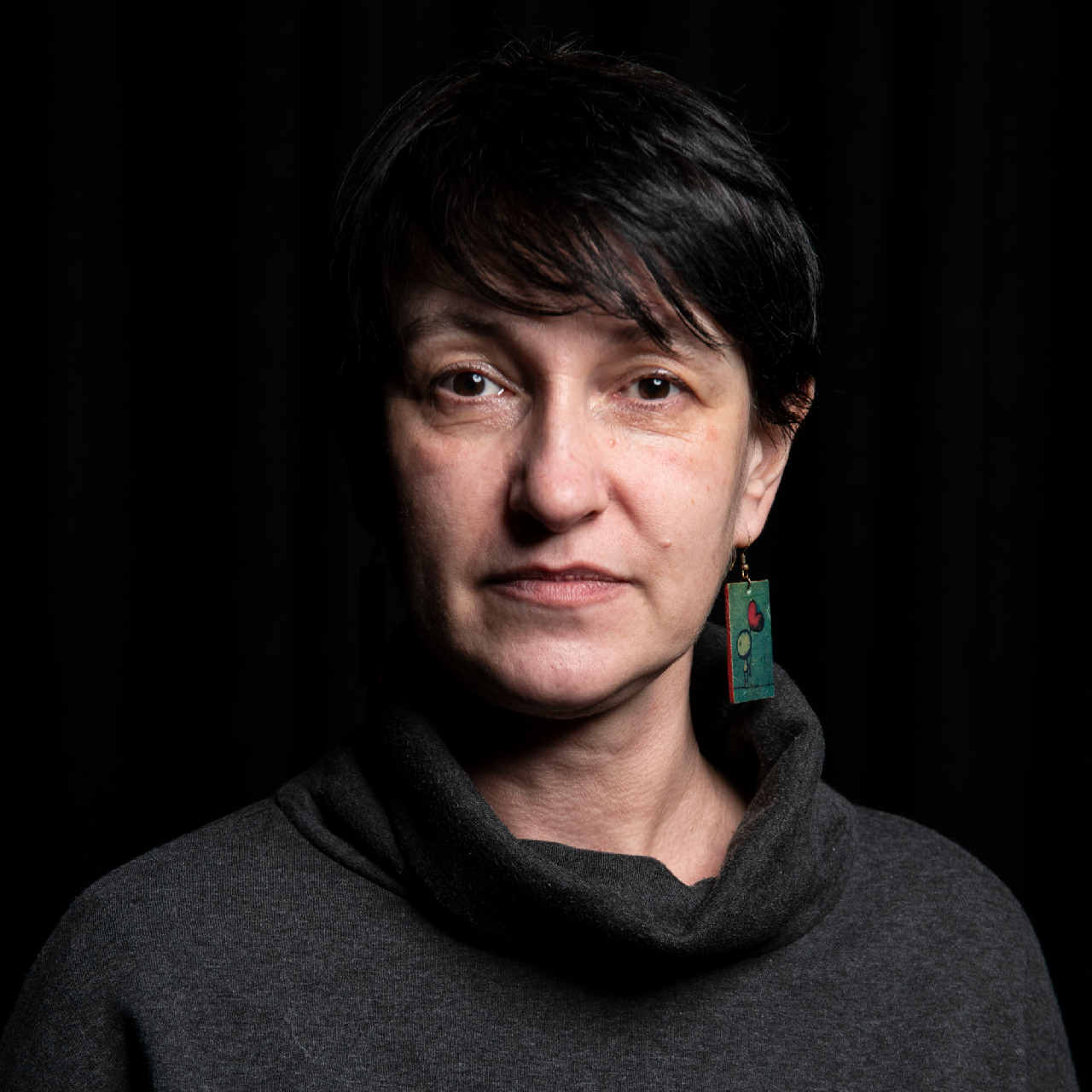As the new school year began in Serbia at the beginning of September, 13 of the newly enrolled children in the south western region of Sandzak, as well as one kindergarten child, were living in refugee camps. These children set off for their first day of the autumn semester with school supplies and bags donated by a local NGO.
Twenty-nine other children could soon join this small group, but only after they have gone through testing in order to determine the grade that they should enroll in, all according to their level of language fluency. But the majority of children of school and preschool age who are living in refugee centers in the Sandzak towns of Tutin and Sjenica will not be joining their peers this year.
Across the country as a whole, out of around 800 registered refugee children between the ages of 7 and 14, only around 150 are enrolled in schools, even though primary education in Serbia is mandatory and schools must be accessible to all. Those pupils that are entering the classrooms are doing so from refugee centers in bad conditions, where they often live in overcrowded rooms.
One of the centers is located near to Tutin, about one kilometer away from the town, in a semi-abandoned industrial zone. Currently, the wooden barracks are inhabited by 80 refugees, mainly from Afghanistan, and almost half of them are children.
In the summer, when we were in Tutin, 33 people were living in the refugee center. However, numbers are constantly changing because for most the Balkans is only intended as a stopping point along their route toward the European Union.
A place long forgotten
In Tutin’s refugee center everybody is living in venues that used to serve as offices, in old barracks which, according to official sources, only partially have an adequate heating system. There is hardly any privacy, no good lighting nor fire alarm system and no medical care rooms. However, around the barracks there are many green areas, where children have places to spend their day and entertain themselves.
During the first half of the year more than 100 persons were crammed into the overcrowded small space. Then in July, a decision was made that many of the refugees should be transported to other centers in Serbia, meaning only a few families with children remained there. It’s rare for somebody to speak any foreign languages, and there are no interpreters.
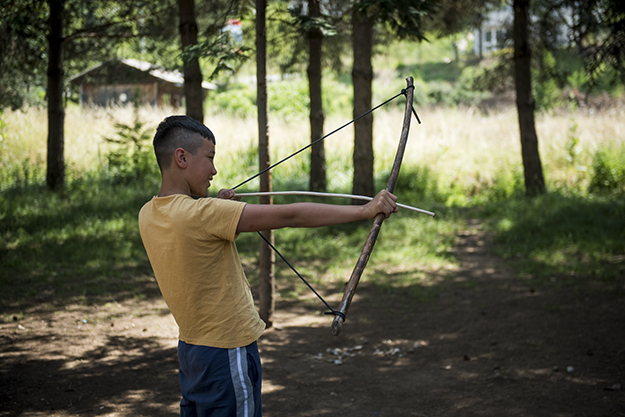
Almost half of those staying in the camp in Tutin are children. Photo: Imrana Kapetanovic.
Everything in this center, just as in the town itself, seems abandoned and forgotten. Sandzak as a whole has the feel of a region long forgotten.
Tutin is the poorest part of Sandzak, which in turn is the poorest part of Serbia. According to the National Employment Services data from April this year, out of 15,000 working-age people, 8,142 people in Tutin are unemployed. The situation is no better in other parts of the province.
It seems that nobody has been maintaining roads that lead to and through Sandzak, parts of which are completely devastated and filled with holes. Almost all road safety barriers are damaged, and traffic rules are effectively nonexistent. Even road signs, if any remain, are old and rusty, and often have directions for cities that are long gone.
Buildings and houses in cities are also abandoned, but huge new buildings are emerging, apparently with no order, and for purposes hard to understand because Sandzak people talk of a mass departure of the population from this area.
In reality, everything is semi-abandoned. The exception is Novi Pazar, the largest city in Sandzak, which is overcrowded but equally abandoned by decision makers and as dismal as the rest of the province.
However, according to public opinion polls in Serbia, refugees that go through the state are best received precisely in these two towns.
“We have many refugees here,” Cemal Hrmak says, while talking with us in the deteriorating shop in nearby Sjenica. When all the factories in Sandzak closed down in the ’80s, the former textile production engineer opened a small shop close to the flea market where he sells dairy products and grilled chicken.
“This area used to be very alive and everybody worked,” he says. “We earned well. But there’s nothing left. We’re left jobless; all the factories have closed down, and we are here trying to survive.” Cemal adds that his simple goal is for all of his children to graduate from faculties — two of them have received a PhD, while the third is still studying — which will enable them to leave Sandzak.
However Sandzak folk are known for their hospitality and Cemal and most other citizens in Sjenica and Tutin have received the refugees as their guests. “We care about the people who have come here,” Cemal says. “We are attempting to help them as much as we can, to give them some work so that they can earn something; we give them food, clothes… whatever we can do with what we have.”
Locals and refugees share the park in Sjenica. The same goes with sport fields that come to life in the afternoon hours. While goats and cows are grazing the grass surfaces, Sjenica residents and refugees are mainly playing volleyball and basketball together.
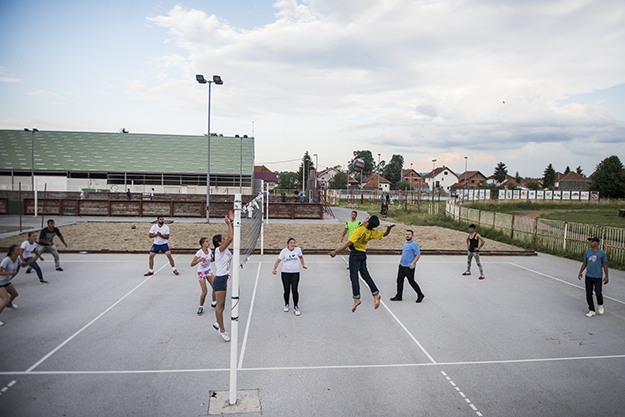
Having equipment is the only difference at the sports field between locals and guests, who are often barefoot. Photo: Imrana Kapetanovic.
Locals have sneakers and are dressed for sports, whereas their guests wear what they have at their disposal. Some are wearing overused jeans, often of inadequate size, while others are playing in sweatshirts and pants. Before participating in the game, many of them remove their shoes, overused from miles of walking in their unsuccessful quests to reach the EU.
Lessons learnt
From the little stand at the side of the court, we observe a volleyball match. Both teams are very mixed — girls, men, locals and refugees. They communicate more with smiles and moves than with words. But there is a lot of laughter.
Svjetlana, one of the girls playing volleyball, says that it is always like that; everybody is together on the sports field. “Some play volleyball really well,” Svjetlana says as we watch the match after hers from the sidelines; she has been attending volleyball training for a couple of years at a local club.
“In the beginning, we were all a bit shy, but now we are used to each other. I’m really glad that they are here, so that we can get to know each other.”
She also tells us how some people from Afghanistan, who now live in one of two camps in Sjenica, came to their high school, following mediation by a local NGO. “They talked to us about their lives in Serbia,” she says. “I was sad when I heard all their stories of life in Afghanistan but also about how they travelled and arrived here. It was also interesting for me to hear that some of them were never close to girls. While now we are playing volleyball together.”
In Sjenica, there are two camps: one located in the venues of the former ‘Vesna’ textile factory and the other in the Berlin Hotel. Those who live in ‘Berlin’ are mostly young men to whom Sjenica is only a place where they have to be while they rest, and then further attempt to reach the EU.
We see them sitting around the hotel and almost everyone is on the phone, through which they maintain contact with family and friends, who can be anywhere on the globe, but also with smugglers who are their last hope of crossing the border and continuing their journeys. But only those who still have money — few in number in Sandzak.
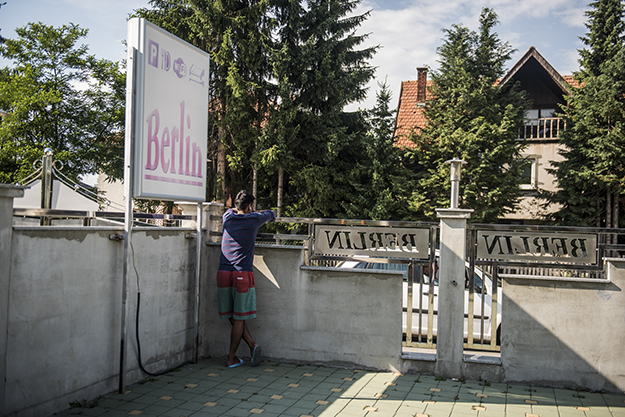
The privately owned Berlin Hotel, one of two refugee centers in Sjenica, shelters men — and boys — who have travelled alone. Photo: Imrana Kapetanovic.
Since the borders closed at the end of March 2016, the only legal way for people who are in Serbia to enter the EU is to get on the list that will permit them to go to Hungary. Currently only 30 people can cross this way per day.
Those who cannot get on the list, mostly single man, attempt to cross to other neighboring countries — often to Montenegro or Bosnia and Herzegovina — and to continue towards the EU from there.
During summer months the number of entries into Bosnia and Herzegovina has significantly increased. Local NGOs working on the ground say that in most cases, instead of being provided with protection, persons that come into contact with the police after crossing the border are taken away or locked up, before quickly being sent back to Serbia.
Among those who have gone through this process are a significant number of minors, about whom there are not even records in Bosnia and Herzegovina. Due to all of this, most refugees decide to journey to Bosnia and Herzegovina only when desperate.
Some try to enter Croatia. One of the crossing points from Serbia is Sid, where there has been ongoing agony for months, with many young men who live in holts close to the border trying every day to cross the border. Some succeed. However many are arrested in Croatia, where refugees have complained that police violence is a threat to them.
Tragically at least six lives have also been lost this summer by refugees trying to cross into Croatia from Serbia as they have attempted to climb onto moving trains and trucks.
‘Never don’t give up’
But life in Sandzak is virtually impossible for many migrants.
Dzeneta Agovic, an activist with the Tutin-based Impuls organization, says that since March the conditions in the Sanzdak refugee centers have significantly improved compared to how they were last winter.
“In Sjenica, everybody was accommodated in the Berlin Hotel with a capacity of perhaps around 200 people,” she recalls. “At one point, there were 480 of them. They were everywhere. There was no hallway, no passage… there was nothing else expect people one after another.”
Agovic adds that during the winter everybody had a tough time, but particularly women: “They didn’t have a crumb of privacy. They couldn’t change in peace, shower in peace… it was impossible to maintain hygiene. They didn’t have sanitary pads, so they chopped up children’s diapers and used them. Children were everywhere… Although, whatever the conditions, life in collective centers is always difficult. The staff working there was exceptional. Everything was tough.”
These conditions continued for months, from November 2016 to the beginning of March, when a center was established in Vesna; families were moved to the new center, while ‘Berlin’ remained a place for men, among them minors who had travelled alone. Ordinarily unaccompanied minors would not be sharing rooms with adults, however it seems that there isn’t any other solution.
As in the Tutin center, it is rare for the young men in ‘Berlin’ to speak a foreign language, and here too there are no interpreters.
In July, when we were in Sjenica, a young man introducing himself as Ferhad (17) from Afghanistan was one of the young men accommodated in ‘Berlin.’ In poor English, he told us how he had been travelling for more than a year. He isn’t sure about where he is travelling to, but hopes it will be far away from the Balkans.
Ferhad says that the people he met in Sjenica are mostly good to him and the others, but that isn’t reason enough for him to stay here. However, he is thankful for the little attention he got from the locals.
During the winter, Ferhad lived in barracks in Belgrade. Then since spring he had been trying to enter the EU. He went to the border with Romania several times, then to attempt entering Hungary and Croatia, but with no success. He said that he was in Sjenica so he could rest and then attempt again. Recently his friend, also a refugee, had tattooed clumsily on his right hand in English: “Never don’t give up.”
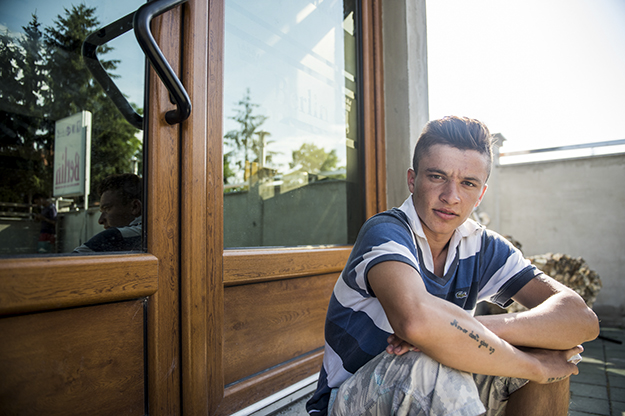
Seventeen-year-old Ferhad from Afghanistan dreams about the European Union, while staying in the ‘Berlin’ camp in Sjenica. Photo: Imrana Kapetanovic.
Most of the young people from ‘Berlin’ leave for the sport courts in the afternoon hours. Ferhad says that this is the only activity that they perform during the day. They spend the rest of the day doing nothing.
We find out that ‘Berlin’ is actually a privately-owned hotel, the owner of which signed a contract with the Municipality, which in turn has a contract with the Commissariat for Refugees and Migration.
In July there was a total of 264 persons in the the two Sjenica centers but by September this number was down to 173.
All apart from the young men and boys who travelled alone now live in the management buildings of the former ‘Vesna’ textile factory. As many as 44 percent of those who live in this center are children. Most of them come to the center from Afghanistan, Iraq, Syria, and Pakistan.
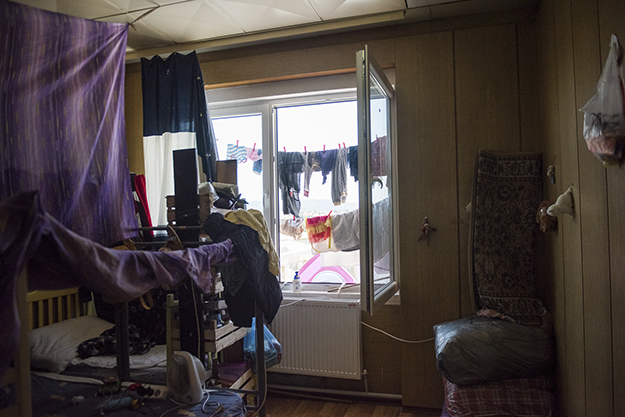
With winter on the way, more than 200 refugees will see its arrival from camps in Sjenica. Photo: Imrana Kapetanovic.
In ‘Vesna,’ refugees are accommodated in former offices transformed into rooms. Iron beds with mattresses were introduced into the venues — besides the old built-in cabinets, this is the only furniture. All the rooms are too small for the number of people living in them, and in some cases there are more than 10 people in one room.

Privacy doesn’t exist in the Sjenica center’s rooms, but some attempt to acquire at least part of the space for themselves by building “walls” of woolen blankets. Photo: Imrana Kapetanovic.
In an attempt to at least have a crumb of privacy, in some rooms beds are divided by ugly woolen blankets. All rooms are too hot, and suffocating, and there is no space for anything but the bare essentials.
Coping with trauma
Galia and her four children live in one of the small former offices at ‘Vesna.’ The eldest, Sanaa, is 11 and an interpreter for almost the entire camp. She says that she learned English on the way there. They have been travelling for a year towards a place that would be good for her family to live in — Sandzak isn’t that place.
The family is from Aleppo. They left in a convoy while the city was bombarded. At that point there were eight of them. A bomb fell close to the column of people they found themselves in, and killed the father and the baby he carried in his arms.
Galia still hasn’t come to terms with this loss, nor has she had the time to do so. After leaving Aleppo she had to find a way to Turkey with her four children alone, and then over the sea towards Greece. They were walking for 11 days non-stop in order to reach Belgrade. On the way, her youngest boy fell, and damaged his eye.
Then they ended up in ‘Vesna,’ with no money and completely lost. While we attempt to talk about the living conditions, she only wants us to look at the photos of her baby and husband that she lost. It seems that these photos are the most valuable things she has got in her phone.
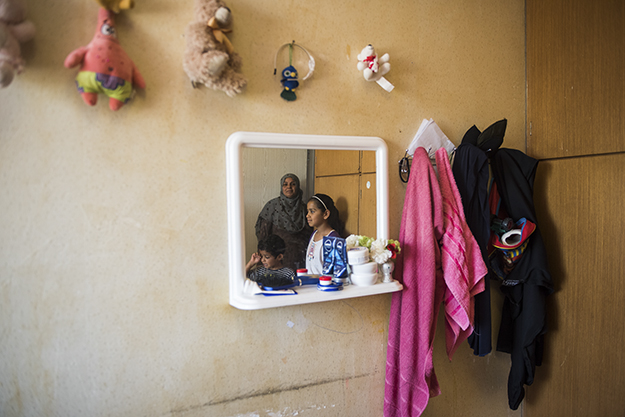
Sanaa and her family traveled from Aleppo in Syria, only to end up in a small room in the ‘Vesna’ center. Photo: Imrana Kapetanovic.
Sanaa interprets her mother’s words, saying how people in Sjenica are good people, but that this isn’t a place to live: “The food isn’t good, and we don’t have the money to buy something. And when we do buy it, the management doesn’t allow us to carry it into the rooms to cook here. For two months they haven’t given us any shampoo or detergents,” Galia told us through our ‘interpreter,’ adding that milk is lacking for the kids and that it is often watery.
The same story is repeated by other people living in the other rooms we visited. They say they believe that the storage areas are full but that the management doesn’t want to share the donations.
In a nearby shop, where those who have money shop, they tell us that in the past few weeks they’ve noticed people staying in the camps have come to buy detergents and shampoos. “We thought they received this help. We saw the trucks bringing those things, but it seems that this isn’t the case still,” the lady working in the shop said. She didn’t want to share her name, but she was open for a conversation.
Even though she doesn’t speak the camp residents’ languages, they are still managing to understand each other. She already knows their preferences. While we sit in a small garden next to the shop, we are met by one young woman. “She likes Pepsi. We don’t sell it in the shop, but we get it for her and keep it in the refrigerator,” she tells us.
She also says that they had realized they lacked detergents in the shop, so they got in a type that isn’t low quality, and that would be affordable to their now first neighbors, and frequent buyers.
Ivan Miskovic, a spokesperson for the Serbian Commissariat for Refugees and Migration rejects all allegations of inadequate distribution of supplies, saying: “When it comes to complaints, they aren’t true. From the budget of the Republic of Serbia, and donations, we cover the aforementioned needs of the migrants. The number of migrants is large, hence their needs are big.”
Allegations of corruption
Washed dresses cover the entrance into the ‘Vesna’ camp. The management hasn’t set up ropes for drying the laundry, hence dresses are hanging from the wire fence surrounding the camp. Those we spoke to say they don’t have summer clothes, which we can observe for ourselves; most inhabitants have long sleeves and warm clothes even though the temperature at the time of our visit exceeds 35 degrees.

Some supplies are getting through to the camps, but there are also complaints about distribution. Photo: Imrana Kapetanovic.
An activist with the Tutin Youth Initiative, Mehdija Medovic, says that there are also issues with donation distribution in the Tutin camp. For months, they had worked with children there, teaching them Serbian and English, and designing a variety of activities, not only for children but also for other inhabitants of the center. He also says that many of those living in the camp have complained about not receiving sufficient donations.
Medovic claims that he witnessed the storage areas where the donations are held himself and had complained multiple times. The ultimate result was that he was denied access to the center.
“I believe that some things from the warehouse will end up somewhere else because they weren’t distributed to the people,” Medovic claims. “That’s why some organizations have donated their help directly to the people.”
Allegations of corruption, indifference towards people accommodated in the Sandzak centers or people paying to receive mildly better conditions within a camp came up from several sources, but nobody wanted to publicly speak about it, and we have not seen documents that would prove these allegations.
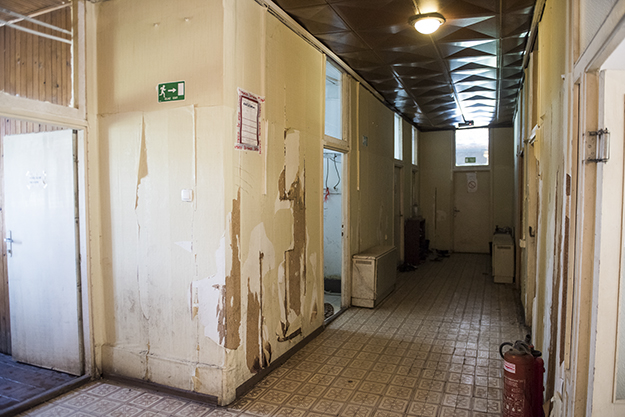
Some refugees have been residing in the camp in Tutin for more than a year, in minimal living conditions. Photo: Imrana Kapetanovic.
However, everything points to the fact that the attitudes of Sandzak citizens towards the refugees is far different from the attitude of the centers’ management.
Soon, a new refugee center will be opened near to Tutin, a little further out than the existing one. However Sandzak is not the solution for anyone who is currently located in the centers we visited. Refugees and migrants reiterated that they want to leave Sandzak and Serbia; sometimes they talk about it in a desperate manner.
When they got on the road a long time ago, they dreamt about going to a better place; in the Balkans, they feel like captives.
Another winter is coming closer, while the conditions in which people in Tutin and Sjenica reside are inhumane, just like most of the centers in Serbia and those along the so-called Balkan route. For now, Europe remains closed for these people, and it is difficult to foresee the future.K










